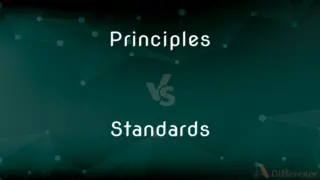Julia vs. Python — What's the Difference?
By Tayyaba Rehman — Published on January 6, 2024
Julia is designed for high-performance numerical analysis and computational science, whereas Python is a general-purpose language with a rich ecosystem.

Difference Between Julia and Python
Table of Contents
ADVERTISEMENT
Key Differences
Julia is a high-level, high-performance dynamic programming language for technical computing, with syntax that is familiar to users of other technical computing environments. It provides a sophisticated compiler, distributed parallel execution, numerical accuracy, and an extensive mathematical function library. Python, on the other hand, is a widely-used high-level, interpreted, and general-purpose dynamic programming language that focuses on code readability.
Julia is known for its performance, which is close to that of statically-typed, compiled languages like C. This is achieved through just-in-time (JIT) compilation using the LLVM framework. Python, while it can be compiled, is typically run as an interpreted language, which means it generally has slower performance compared to Julia. However, Python can achieve near-C speed through extensions like Cython or when using optimization libraries like Numba.
Julia's ecosystem, particularly for data science and numerical computation, is growing but it's not as mature as Python's. Python boasts a vast number of libraries for various applications, from web development to data analysis (Pandas), and machine learning (TensorFlow, scikit-learn).
Julia uses multiple dispatch as a paradigm, allowing it to choose which function to execute based on the types of all arguments. This can make it easier to write certain kinds of high-performance code. Python, meanwhile, typically relies on single dispatch and is often used in a more procedural or object-oriented fashion.
While Julia was explicitly designed to handle numerical and scientific computing with ease, Python is versatile in handling all sorts of applications, from web servers to desktop apps, with a syntax that is considered to be clear and readable for beginners and professionals alike.
ADVERTISEMENT
Comparison Chart
Design Focus
High-performance numerical and technical computing.
General-purpose programming.
Performance
JIT compilation for high performance.
Interpreted, with options for JIT compilation.
Numerical Computing
Built-in and efficient by design.
Requires additional libraries (like NumPy).
Syntax
Similar to MATLAB, favors technical computing.
Highly readable, favors simplicity.
Libraries and Ecosystem
Growing, especially in data science.
Rich and mature, with extensive libraries.
Type System
Dynamic with a focus on multiple dispatch.
Dynamic, with single dispatch object orientation.
Ideal Use Case
Scientific research, heavy numerical computations.
Web development, scripting, scientific research.
Community and Support
Smaller, but growing community.
Large, well-established community.
Machine Learning Support
Emerging with libraries like Flux.jl.
Extensive, with libraries like TensorFlow.
Execution
Compiled through JIT, tends to be faster.
Interpreted or optionally compiled, typically slower.
Compare with Definitions
Julia
It is optimized for technical computing.
For our simulation, Julia provides out-of-the-box parallel computing capabilities.
Python
Python is a versatile general-purpose programming language.
I built my website's backend using Python because of its flexibility.
Julia
Julia has a dynamic type system.
Julia's dynamic typing allows for flexible function definitions.
Python
Python emphasizes code readability.
Python's readable syntax makes it easy to maintain and update the code.
Julia
Julia has a syntax that is easy for those familiar with other technical computing environments.
Transitioning from MATLAB to Julia was straightforward due to the similar syntax.
Python
Python is one of the most popular programming languages.
At the university, we learn Python because of its wide applications in the industry.
Julia
Julia uses multiple dispatch as a core programming paradigm.
Multiple dispatch in Julia allows my functions to be more generic and powerful.
Python
It has a rich set of libraries for various tasks.
Python's extensive libraries made data processing for my project a breeze.
Julia
Julia is designed for high-performance computing.
We're rewriting our data analysis scripts in Julia to improve speed.
Python
It supports object-oriented programming paradigms.
The object-oriented nature of Python allows for organizing my project into modular classes.
Common Curiosities
Can I use Python libraries in Julia?
Yes, Julia has packages like PyCall that allow you to use Python libraries within Julia.
Is Julia easy to learn for Python programmers?
Yes, Julia's syntax is straightforward for those who are familiar with Python.
What's the main advantage of Julia over Python?
Julia's main advantage is its ability to handle complex numerical computations more efficiently.
Can Python match Julia's performance?
Python can be optimized to be nearly as fast as Julia but typically requires additional tools or libraries.
For a data science career, should I learn Julia or Python?
Python is more in demand in data science, but knowing Julia can be an asset for performance-critical tasks.
Is Julia better than Python for data analysis?
Julia is designed for high-performance computing, but Python has more mature data analysis libraries.
Is Julia's syntax similar to Python's?
Julia's syntax is not as similar to Python's as it is to MATLAB's, but it is still clear and accessible.
Which language has better support for parallel computing?
Julia has built-in support for parallel and distributed computing.
Is Python good for beginners?
Yes, Python is often recommended for beginners due to its readability and simplicity.
Are Julia and Python interoperable?
Yes, you can call Python code from Julia and vice versa, allowing for interoperability between the two.
How extensive is Julia's standard library compared to Python's?
Python's standard library is more extensive, while Julia's is growing but more focused on technical computing.
Can I do web development with Julia as with Python?
While possible, web development is more common and supported in Python.
What are the IDE options for Julia and Python?
Both languages can be used with various IDEs, with Python having broader support due to its popularity.
Are Python's machine learning libraries better than Julia's?
Python's machine learning libraries are currently more established than Julia's.
Does Julia replace Python in scientific computing?
Julia offers advantages in certain scientific computing scenarios but doesn't completely replace Python.
Share Your Discovery

Previous Comparison
Principles vs. Standards
Next Comparison
OpenGL vs. DirectXAuthor Spotlight
Written by
Tayyaba RehmanTayyaba Rehman is a distinguished writer, currently serving as a primary contributor to askdifference.com. As a researcher in semantics and etymology, Tayyaba's passion for the complexity of languages and their distinctions has found a perfect home on the platform. Tayyaba delves into the intricacies of language, distinguishing between commonly confused words and phrases, thereby providing clarity for readers worldwide.














































